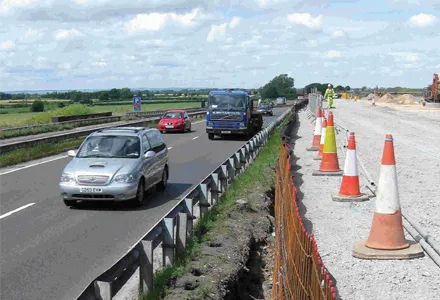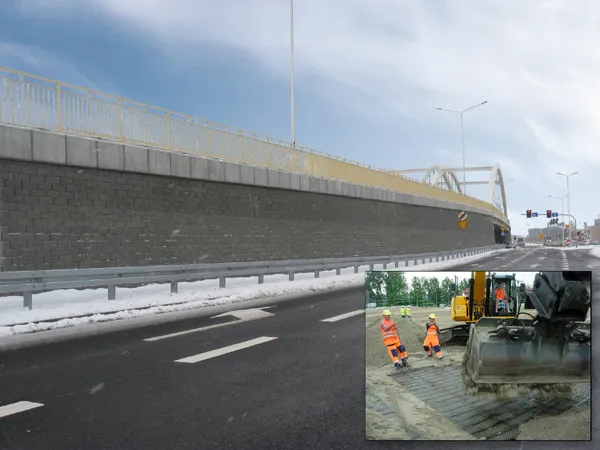Technology from Tensar played a vital role along the Dishforth-Leeming section of the North Yorkshire A1 improvement work in northern England where new carriageways are being built adjacent to the existing in-use highway.
February 17, 2012
Read time: 2 mins

Technology from 340 Tensar played a vital role along the Dishforth-Leeming section of the North Yorkshire A1 improvement work in northern England where new carriageways are being built adjacent to the existing in-use highway.
By using a Tensartech TR2 Wall solution to create a temporary structure while raising a below grade section, the2435 Carillion/2567 Morgan Sindall joint venture contractors are saving time and helping to minimise traffic disruption.
The existing 150m section of the A1 road either side of the Butcher House Bridge is up to 10m below the final required grade of the new motorway. An earth retaining structure with a near vertical face was required to support the new dual three-lane carriageway, which would allow the traffic to be switched to it while the old section was filled.
The conventional technique using extensive sheet piling along the embankment and for the bridge abutments to relieve lateral thrust would have been time consuming, and access for the equipment could have disrupted traffic flow.
Tensar developed a quick-to-install reinforced earth solution. With minimal disturbance to vehicles it temporarily supported the new south-bound embankment, bridge wing walls and abutments.
The contractor explained that as a temporary sacrificial structure, this was by far the best option and less expensive than other methods available.
The solution comprised compacted fill reinforced with layers of Tensar's uniaxial geogrid, securely connected to steel mesh facing units to form a 100m length of the 85˚ earth retaining structure up to152 3M high; site won fill was used for this section.
For the bridge abutments and wing walls, a 26m length of vertical faced TR2 face, using imported granular fill and uniaxial geogrids, was built up to 9.5m. At either end of the embankment, a 45˚ slope was constructed using Tensartech.
By using a Tensartech TR2 Wall solution to create a temporary structure while raising a below grade section, the
The existing 150m section of the A1 road either side of the Butcher House Bridge is up to 10m below the final required grade of the new motorway. An earth retaining structure with a near vertical face was required to support the new dual three-lane carriageway, which would allow the traffic to be switched to it while the old section was filled.
The conventional technique using extensive sheet piling along the embankment and for the bridge abutments to relieve lateral thrust would have been time consuming, and access for the equipment could have disrupted traffic flow.
Tensar developed a quick-to-install reinforced earth solution. With minimal disturbance to vehicles it temporarily supported the new south-bound embankment, bridge wing walls and abutments.
The contractor explained that as a temporary sacrificial structure, this was by far the best option and less expensive than other methods available.
The solution comprised compacted fill reinforced with layers of Tensar's uniaxial geogrid, securely connected to steel mesh facing units to form a 100m length of the 85˚ earth retaining structure up to
For the bridge abutments and wing walls, a 26m length of vertical faced TR2 face, using imported granular fill and uniaxial geogrids, was built up to 9.5m. At either end of the embankment, a 45˚ slope was constructed using Tensartech.








